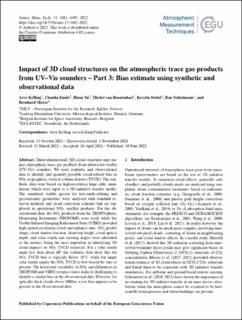| dc.contributor.author | Kylling, Arve | |
| dc.contributor.author | Emde, Claudia | |
| dc.contributor.author | Yu, Huan | |
| dc.contributor.author | van Roozendael, Michel | |
| dc.contributor.author | Stebel, Kerstin | |
| dc.contributor.author | Veihelmann, Ben | |
| dc.contributor.author | Mayer, Bernhard | |
| dc.date.accessioned | 2022-06-14T07:28:02Z | |
| dc.date.available | 2022-06-14T07:28:02Z | |
| dc.date.created | 2022-06-13T09:36:10Z | |
| dc.date.issued | 2022 | |
| dc.identifier.citation | Atmospheric Measurement Techniques. 2022, 15, 3481-3495. | en_US |
| dc.identifier.issn | 1867-1381 | |
| dc.identifier.uri | https://hdl.handle.net/11250/2998612 | |
| dc.description.abstract | Three-dimensional (3D) cloud structures may impact atmospheric trace gas products from ultraviolet–visible (UV–Vis) sounders. We used synthetic and observational data to identify and quantify possible cloud-related bias in NO2 tropospheric vertical column density (TVCD). The synthetic data were based on high-resolution large eddy simulations which were input to a 3D radiative transfer model. The simulated visible spectra for low-earth-orbiting and geostationary geometries were analysed with standard retrieval methods and cloud correction schemes that are employed in operational NO2 satellite products. For the observational data, the NO2 products from the TROPOspheric Monitoring Instrument (TROPOMI) were used, while the Visible Infrared Imaging Radiometer Suite (VIIRS) provided high-spatial-resolution cloud and radiance data. NO2 profile shape, cloud shadow fraction, cloud top height, cloud optical depth, and solar zenith and viewing angles were identified as the metrics being the most important in identifying 3D cloud impacts on NO2 TVCD retrievals. For a solar zenith angle less than about 40∘ the synthetic data show that the NO2 TVCD bias is typically below 10 %, while for larger solar zenith angles the NO2 TVCD is low-biased by tens of percent. The horizontal variability of NO2 and differences in TROPOMI and VIIRS overpass times make it challenging to identify a similar bias in the observational data. However, for optically thick clouds above 3000 m, a low bias appears to be present in the observational data. | en_US |
| dc.language.iso | eng | en_US |
| dc.rights | Navngivelse 4.0 Internasjonal | * |
| dc.rights.uri | http://creativecommons.org/licenses/by/4.0/deed.no | * |
| dc.title | Impact of 3D cloud structures on the atmospheric trace gas products from UV–Vis sounders – Part 3: Bias estimate using synthetic and observational data | en_US |
| dc.title.alternative | Impact of 3D cloud structures on the atmospheric trace gas products from UV–Vis sounders – Part 3: Bias estimate using synthetic and observational data | en_US |
| dc.type | Peer reviewed | en_US |
| dc.type | Journal article | en_US |
| dc.description.version | publishedVersion | en_US |
| dc.rights.holder | © Author(s) 2022. | en_US |
| dc.source.pagenumber | 3481-3495 | en_US |
| dc.source.volume | 15 | en_US |
| dc.source.journal | Atmospheric Measurement Techniques | en_US |
| dc.identifier.doi | 10.5194/amt-15-3481-2022 | |
| dc.identifier.cristin | 2031258 | |
| dc.relation.project | ESA - den europeiske romfartsorganisasjonen: 4000124890/18/NL/FF/gp | en_US |
| dc.relation.project | NILU - Norsk institutt for luftforskning: 118104 | en_US |
| cristin.ispublished | true | |
| cristin.fulltext | original | |
| cristin.qualitycode | 1 | |

